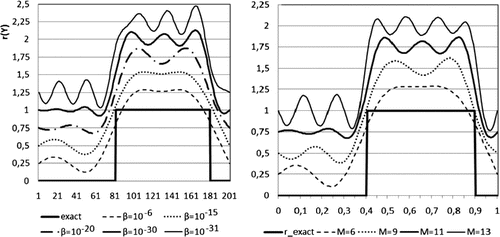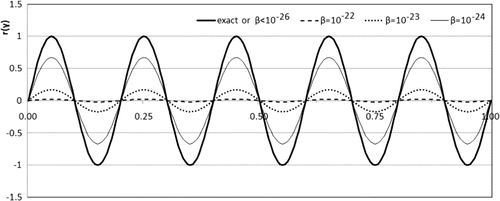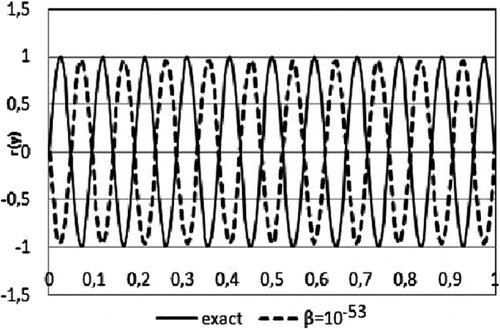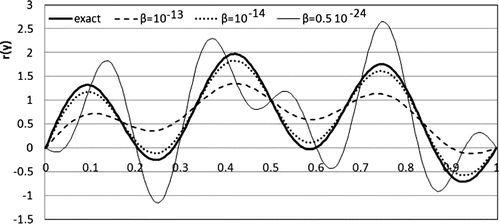 ?Mathematical formulae have been encoded as MathML and are displayed in this HTML version using MathJax in order to improve their display. Uncheck the box to turn MathJax off. This feature requires Javascript. Click on a formula to zoom.
?Mathematical formulae have been encoded as MathML and are displayed in this HTML version using MathJax in order to improve their display. Uncheck the box to turn MathJax off. This feature requires Javascript. Click on a formula to zoom.Abstract
This study explores an application of the quasi-solution and the Fourier methods used to solve a mixed initial-boundary problem involving Laplace’s equation in a rectangle. The problem is reduced to a system consisting of mutually dependent direct and adjoint problems. The explicit formula for the quasi-solution is obtained using the Fourier method. Computational experiments are performed for different types of synthetic data, and admissible parameter ranges are established.
1 Introduction
Laplace’s and Poisson’s equations are commonly studied mathematical models used in applications involving both direct and inverse problems. In many practical cases, a whole boundary for a given domain is unavailable, and boundary data cannot be stated explicitly. For instance, in geophysical applications, much of the boundary of an object of interest is not available for measurement. Hence, recovery of the boundary data is an important and practical problem [Citation1, Citation2]. All possible measurements for the available portion of the boundary are used as additional information. This work concerns the application of Fourier and quasi-solution methods to solve mixed initial-boundary problem using Laplace’s equation in a rectangle. This is a classical inverse problem studied by many authors [Citation3–Citation8]. We consider the same statement given in [Citation5], but we neither minimise the residual functional by any gradient method, nor do we use other iterative methods. Instead, we find a solution to the given problem by using a necessary minimum condition for the residual.
Use of the Fourier method to investigate the Cauchy problem for Laplace’s equation was applied for the first time in [Citation7]. An iterative method used to solve an initial-boundary problem using Laplace’s equation was developed in [Citation6], where initial data were complemented by additional data on one side of the boundary. The quasi-solution method [Citation9] is the most useful method for an investigation of problems of this type [Citation5–Citation10]. By this method, a given inverse problem is reduced to an optimal control problem that can be solved using corresponding techniques. In many cases, the gradient of the residual functional is expressed in terms of the solution to the adjoint problem [Citation3, Citation5, Citation10–Citation16].
Therefore, this solution is useful for the numerical calculation of the gradient [Citation3, Citation5, Citation6, Citation10–Citation13]. Under certain conditions, the optimal control can be expressed in terms of the solutions to direct and adjoint problems [Citation11, Citation16–Citation21]. Necessary optimality conditions lead to the joined system that consists of direct and adjoint problems [Citation16–Citation21]. The solution, if it exists, satisfies the necessary optimality conditions. If the residual functional is convex, then a necessary condition is also sufficient for optimality. To the best of our knowledge, authors of [Citation16, Citation17, Citation20] pioneer to use such an approach to an optimal control problem concerning processes in distributed objects. The solvability of a system consisting of mutually dependent direct and adjoint problems was first considered in [Citation21] in the case of the 1D quasi-linear parabolic equation. Further, this problem was investigated in detail in [Citation22]. We are not aware of any reference to the application of Fourier methods for numerical solutions to such systems.
In most cases, optimal control conditions lead to a nonlinear system; therefore, the Fourier method cannot be applied directly. In many cases, the solution to an adjoint problem is used to find a gradient of the functional, but a simultaneous solution for coupled direct and adjoint problems is not considered [Citation3, Citation5, Citation6, Citation10–Citation13].
We consider the same statement as in [Citation5], but we do not minimise the residual functional by any gradient method and do not use other iterative methods, as is done in [Citation5]. Instead, we find a solution to the given problem by using a necessary minimum condition for the residual. The system forms the necessary optimality condition that expresses the equality to zero at the first variation of the functional at the extremum point. In [Citation5], the solution to the adjoint problem is used only to find a gradient of the residual. Compared with [Citation5], the main difference of the presented work is that we directly solve a coupled system consisting of direct and adjoint problems. Then, we obtain an explicit formula for the solution of the given inverse problem. Furthermore, we do not apply any gradient methods to obtain numerical solutions. In [Citation5], only one example of the numerical solution corresponding to the first harmonic has been considered; in the present work, we analyse different cases with a high number of harmonics and a discontinuous sought-for function.
This method makes it possible to realise a large number of numerical simulations and find admissible values of a regularisation parameter in different cases. The explicit formula for the solution allows one to study the solution in detail; this is an additional advantage of the presented method. The problems concerning convexity of the residual functional and sufficient conditions of optimality are outside the scope of this work.
The paper is organised as follows: in Section 2, the statement of the problem is given, and the residual functional is constructed; in Section 3, the explicit formula for the solution to a system consisting of mutually dependent direct and adjoint problems is derived using the Fourier method; and results of computational experiments are presented in Section 4.
2 The statement to the problem
We consider the following problem:
Find the function at the boundary
where
is the solution to the initial-boundary value problem for Poisson’s equation
1
1 Assume that
and the following consistence conditions hold true
2
2 Let us rewrite the statement (Equation2.1
1
1 )-(Equation2.2
2
2 ). The solution U(x,y) to the problem (Equation2.1
1
1 )-(Equation2.2
2
2 ) can be represented as
, where functions
and
are the solutions to the problems formulated below:
3
3 and
4
4 Here the function
is unknown:
5
5 Then, the sought-for function is expressed as
The problem (Equation2.3
3
3 ) is a classical statement of the Dirichlet problem for Poisson’s equation and is solved uniquely by
. The normal derivative
on the boundary
exists and is continuous [Citation23]. Therefore, the original problem (Equation2.1
1
1 )-(Equation2.2
2
2 ) is reduced to the initial boundary value problem (Equation2.4
4
4 ) for Laplace’s equation. Let us apply the quasi-solution method [Citation9] to the problem (Equation2.4
4
4 )-(Equation2.5
5
5 ). Namely, the required function
will be found as a solution to the following minimisation problem:
6
6 Here, the derivative
is obtained by the following: we define the function
, use it as a boundary condition at the boundary
, solve the Dirichlet problem for the function
, and find
. Here,
is a regularisation parameter [Citation24].
We consider the following set of admissible functions ):
Let us introduce the following adjoint problem:
7
7 Authors of [Citation5] have shown that the solution to the minimisation problem (Equation2.6
6
6 ) is expressed as
8
8 Using the formula (Equation2.8
8
8 ) in (Equation2.4
4
4 ) as a boundary condition, we obtain the following coupled system of direct and adjoint problems, which need to be solved simultaneously:
9
9
10
10
3 The solution to the problem
The problem (Equation2.99
9 )-(Equation2.10
10
10 ) is a linear one. As the Fourier method is useful in solving linear problems, we shall apply it. First, we follow the standard procedure by separating the variables. Then, we find the function
in the following form:
11
11 Analogously, do the same for v(x,y):
12
12 The presentation (Equation3.1
1
1 ), (Equation3.2
2
2 ) automatically obeys the conditions for
and
at the boundaries
, and the boundary condition for the function
. Now, we find the coefficients of the series (Equation3.1
1
1 ) and (Equation3.2
2
2 ) to satisfy the conditions for
. Let the function
be represented by its Fourier series, which exists based on the assumptions, as follows:
13
13 Next, we substitute the above formulas into the boundary conditions:
. Then, we have:
This yields
Now, by writing (Equation3.1
1
1 ) and (Equation3.2
2
2 ) for
and
, and taking derivatives, we obtain the following expressions:
14
14 Next, we substitute the above formulas into the boundary conditions:
15
15 Using (Equation3.5
5
5 ), we obtain a linear algebraic system defining
and
:
16
16 The explicit formula for the solution is
17
17 Now, we are ready to determine the sought-for function r(y) using the formula (Equation2.8
8
8 ):
18
18 However, we have to justify the convergence of the series (Equation3.8
8
8 ). First, we need to estimate the order of diminishing coefficients. We take into account that for sufficiently large values of
we have
Then, for large
it holds that:
19
19 The estimate above guarantees the convergence of the series (Equation3.8
8
8 ) for each
because
belongs to
. As a by-product of the formula (Equation3.8
8
8 ), we obtain an estimate for
in terms of
as follows:
20
20 Here, we have used Holder’s inequality. Because the last sum in the expression (Equation3.10
10
10 ) is dominated by the integral
we obtain the following estimate in
-norm:
21
21 Note that if the set of functions
is restricted by a finite number of harmonics in (Equation3.3
3
3 ), then the formula (Equation3.8
8
8 ) covers the case
as well. It follows from [Citation7] that, in this case, the system (Equation2.9
9
9 )-(Equation2.10
10
10 ) has the only solution
, and the initial-boundary problem for the function
can be solved independently using the Fourier method as noted above. Then, the solution to the problem (Equation3.8
8
8 ) is defined for
and is given by the formula:
The value of the functional is defined by a finite number of terms in (Equation3.8
8
8 ) as well. The functional in this case vanishes; therefore, in the above mentioned finite-dimensional case the formula (Equation3.8
8
8 ) gives the exact solution.
We now find the expression for the residual functional corresponding to the obtained r(y). Using the last line of (Equation2.1010
10 ), we substitute (Equation3.4
4
4 ) and (Equation3.8
8
8 ) into (Equation2.6
6
6 ) and integrate:
Finally, by using expressions (Equation3.7
7
7 ) for
, we obtain:
If
is positive then we can rewrite the formula above in the following form:
22
22 As right hand side of (Equation3.12
12
12 ) are dominated by
, these series converge for
on the given set of
.
4 Synthesis of measured data
To solve an inverse problem, we need a synthetic function . First, we define a function
and then solve the direct problem. Then, by using this solution, we calculate its derivative
and use it as additional information in the inverse problem. We solve the direct problem numerically using the Fourier method with a finite number of harmonics.
Let the function be presented by its Fourier series:
23
23 The solution to the direct problem is found using the Fourier method and is given by the following formulas:
Then its first derivative is defined as
Therefore the synthetic function
can be written in the form
24
24 Thus, we calculate the Fourier coefficients of the function
, find the function
,then forget the function
, and recover it as if it were unknown.
4.1 Numerical method
Let us describe the numerical algorithm. In our numerical simulations we take values and
only, and consider the unknown function at grid points
. The main steps of the numerical method are:
| 1. | Data synthesis
| ||||||||||||||||||||||
| 2. | Give the number | ||||||||||||||||||||||
Due to the linearity of the problem (Equation2.88
8 ) -(Equation2.9
9
9 ), and according to (Equation3.8
8
8 ), any linear combination
corresponds to the linear combination
Therefore, in our investigation, we can consider the case of unique harmonic such as
By (Equation4.2
2
2 ), the
-th harmonic is presented in the function
with a coefficient
that exponentially decreases with respect to
. This yields quality loss in the result when a frequency
increases. When we analyse the formulas (Equation3.8
8
8 ), we see that the coefficient corresponding to the frequency number k is equal to
and it decreases like
Therefore, to take into account these harmonics, we need to use a small value of for a high
. The higher
we consider, the smaller a parameter
need be. For instance, when
we have obtained an admissible result for
only. The numerical results for different values of
and
are compared in Figure .
Table contains corresponding values of the parameter , frequencies, residual errors, and relative errors in the case
. Here, the relative error is defined as
When
, we need to take
close to machine precision. However, when we take
, the method does not work. For example, the result for
reveals only the qualitative agreement with an exact solution (see Figure ).
Table 1. Harmonic’s numbers , corresponding admissible values of
and relative errors
.
Table 2. Relative errors for different parameter
in the cases of discontinuous (c1) and smooth (c2) functions
Figure 3. The influence of the regularization parameter and the number of harmonics
to the solution in the case of discontinuous
.

Further, more complicated cases of the function are considered. We take up well-behaved functions
as well as a discontinuous one. Relative errors for these two cases are compared in Table . It turns out that due to round-off errors, the case of small values of
yields numerical instability for
. The use of
is not worthwhile (Figure , left). In Figure , for the sake of clarity, graphs corresponding to different parameters are shifted vertically.
Our numerical simulations show that in the case of strictly positive , we need to limit the number of harmonics to no more than 15–18. Only in this case does the required function recover with satisfactory quality.
The case is considered as well. We recover the solution using the formula (Equation3.7
7
7 ). Acceptable results are obtained for
only.
The results in the case of discontinuous r(y) with and
are similar to those with
and
. The corresponding graphs are depicted in Figure . However, when the function
is a linear combination of no more than
harmonics, the quality of recovery is high enough.
Numerical experiments show that the use of small is preferable to
. From a practical point of view, if, by analysing the measured data
and other reasonable additional information, we estimate that the contribution of high harmonics with
can be neglected, then we can choose the parameter
(Figure ).
5 Conclusions
In our opinion, use of the Fourier method is an efficient way to solve the given problem. We can choose to either use it directly or to apply it using a quasi-solution approach. Numerical simulations show that the use of small leads to better results than applying the Fourier method directly by taking
. In addition, the case
lets us consider a greater number of harmonics. We have determined more admissible values of the main parameters such as a harmonic number and a regularisation parameter. It turns out that the most useful range for
is above
, and the most useful range for
is 15–18.
Acknowledgments
The author is grateful to professors M. Otelbaev, T.S. Kalmenov, B.E. Kanguzhin, and M.A. Sadybekov and to other participants of the Fundamental Mathematics Seminar in Almaty, Kazakhstan for their attention to this work and for valuable discussion related to this work. The author is also grateful to the anonymous reviewers for their valuable comments that helped to improve the manuscript. This work has been supported by the Ministry of Education and Science of the Republic of Kazakhstan, grant number 1631-29.09.2012.
References
- O.M.Alifanov, Inverse Heat Transfer Problems, Springer, Berlin, 1994.
- E.J.Kassab, E.Divo, and J.S.Kapat, Multi-dimensional heat flux reconstruction using narrow-band thermochromic liquid crystal thermography, Inverse Probl. Sci. Eng. 9(7) (2001), pp. 537–559.
- L.Bourgeois and J.Darde, A duality-based method of quasi-reversibility to solve the Cauchy problem in the presence of noisy data. Inverse Prob. 26 (2010), p. 095016.
- HuiCao, M.V.Klibanov, and S.V.Pereverzev, A Carleman estimate and the balancing principle in the quasi-reversibility method for solving the Cauchy problem for the Laplace equation, Inverse Prob. 25 (2009), p. 035005.
- S.Kabanikhin, M.A.Bektemesov, A.T.Ayapbergenova, and D.V.Nechaev, Optimization methods of solving continuation problems. Vichisli. Tekhnol. Comp. Tech. SB RAS 9 (2004), pp. 50–60.
- V.A.Kozlov, A.F.Fomin, and V.G.Maz’ja, An iterative method for solving the Cauchy problem for elliptic equations, USSR, Comput. Math. Math. Phys. 31 (1991), pp. 45–52.
- M.M.Lavrent’ev, On the Cauchy problem for the Laplace equation, Izvest. Akad. Nauk. SSSR, Ser. Mat.20 (1956), pp. 819–842.
- L.E.Payne, Bounds in the Cauchy problem for the Laplace equation, Arch. Ration. Mech. Anal.5 (1960), pp. 35–45.
- V.K.Ivanov, On ill-posed problems, Mat. Sbornik61(2) (1963), pp. 211–223 (in Russian).
- N.Zabaras and J.Liu, An analysis of two-dimensional linear inverse heat transfer problems using an integral method, Num. Heat Transf. 13 (1988), pp. 527–33.
- F.P.Vasil’ev, Methods for Solving Extremal Problems, Nauka, Moscow, 1981.
- A.Hasanov, P.Duchateau, and B.Pektas, An adjoint problem approach and coarse-fine mesh method for identification of the diffusion coefficient in a linear parabolic equation, J. Inverse Ill-posed Prob. 14(5) (2006), pp. 435–463.
- L.Beilina, M.V.Klibanov, and M. Yu.Kokurin, Adaptivity with relaxation for ill-posed problems and global convergence for a coefficient inverse problem, J. Math. Sci.167(3) (2009), pp. 279–325.
- L.Beilina and M.V.Klibanov, Approximate Global Convergence and Adaptivity for Coefficient Inverse Problems, Springer, New York, 2012.
- A.I.Egorov, On optimal control of processes in distributed objects, J. Appl. Math. Mech.27(4) (1963), pp. 1045–1058.
- A.I.Egorov, Optimal control of thermal and diffusion processes, Nauka, Moskow, 1978 (In Russian).
- L.V.Petuhov and V.F.Troitskiy, Variational optimization problems, Appl. Math. Mech. 34(2) (1972), pp. 578–588 (In Russian).
- V.I.Plotnikov,Necessary and sufficient optimality conditions and uniqueness conditions for optimizing functions for control systems of general type, Math. USSR Izv. 6(3) (1972), pp. 649–676 (In Russian).
- L.S.Pontryagin, Selected works, The Mathematical Theory of Optimal Processes, Vol. 4, CRC Press, New York, 1987.
- O.G.Provorova, On a question of control process described by a quasi linear parabolic equation, Upavliaemye sistremy, Nauka, Siberian Branch, Novosibirsk, 1973 (In Russian).
- B.D.Tajibaev, On optimality conditions in one control problem, Upavliaemye sistremy, Nauka, Siberian Branch, Novosibirsk, 1988 (In Russian).
- V.S.Belonosov, Interior estimates for solutions to quasiparabolic systems, Siber. Math. J.37(1) (1996), pp. 17–32.
- O.A.Ladyzenskaja, V.A.Solonnikov, and N.N.Ural’ceva, Linear and Quasi-linear Equations of Parabolic Type. Translations of Mathematical Monographs, Vol. 23, AMS, Providence, RI, 1968.
- A.Tikhonov and V.Arsenin, Solution of Ill-Posed Problems, John Wiley, New York, 1977.


